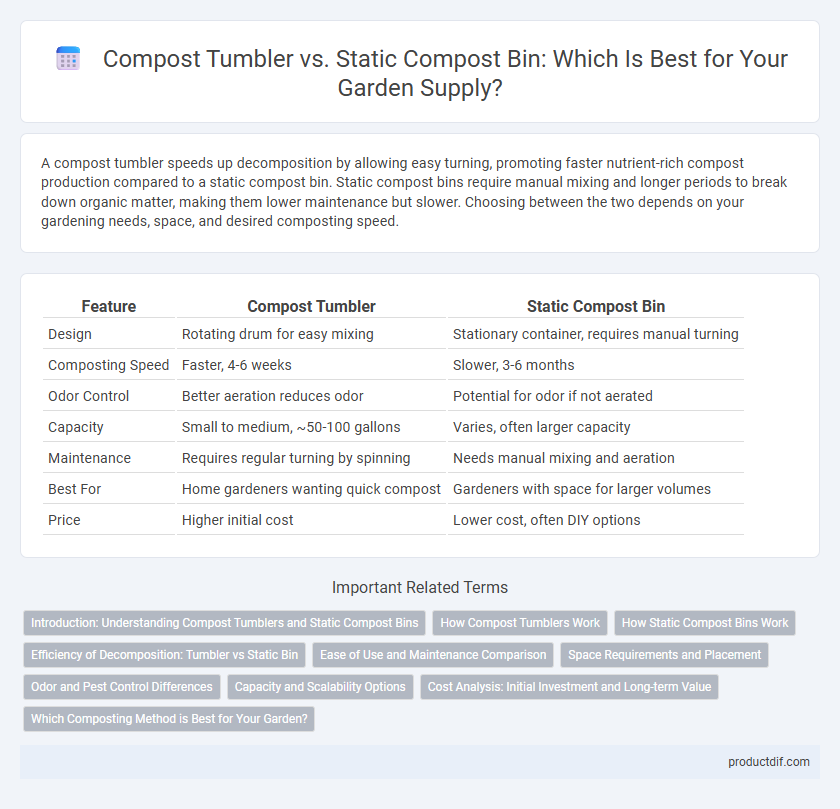A compost tumbler speeds up decomposition by allowing easy turning, promoting faster nutrient-rich compost production compared to a static compost bin. Static compost bins require manual mixing and longer periods to break down organic matter, making them lower maintenance but slower. Choosing between the two depends on your gardening needs, space, and desired composting speed.
Table of Comparison
| Feature | Compost Tumbler | Static Compost Bin |
|---|---|---|
| Design | Rotating drum for easy mixing | Stationary container, requires manual turning |
| Composting Speed | Faster, 4-6 weeks | Slower, 3-6 months |
| Odor Control | Better aeration reduces odor | Potential for odor if not aerated |
| Capacity | Small to medium, ~50-100 gallons | Varies, often larger capacity |
| Maintenance | Requires regular turning by spinning | Needs manual mixing and aeration |
| Best For | Home gardeners wanting quick compost | Gardeners with space for larger volumes |
| Price | Higher initial cost | Lower cost, often DIY options |
Introduction: Understanding Compost Tumblers and Static Compost Bins
Compost tumblers and static compost bins serve as essential tools for effective garden waste recycling, each designed to optimize decomposition under different conditions. Compost tumblers accelerate decomposition through regular aeration achieved by rotating the cylindrical container, which mixes organic materials and maintains oxygen flow. In contrast, static compost bins rely on passive management, requiring manual turning or aeration to prevent anaerobic conditions and support microbial activity.
How Compost Tumblers Work
Compost tumblers work by allowing users to easily rotate the enclosed drum, which aerates the organic material and accelerates the decomposition process. The design ensures consistent oxygen flow and moisture distribution, leading to faster breakdown of kitchen scraps and garden waste compared to static compost bins. This continuous tumbling action reduces odor and produces nutrient-rich compost suitable for garden soil improvement.
How Static Compost Bins Work
Static compost bins operate by allowing organic waste to decompose naturally over time within a contained environment, promoting aerobic microbial activity without the need for frequent turning. These bins are designed with ventilation holes to enhance airflow, facilitating the breakdown of materials into nutrient-rich compost suitable for garden use. The passive decomposition process in static bins requires patience but offers a low-maintenance solution for recycling garden and kitchen waste efficiently.
Efficiency of Decomposition: Tumbler vs Static Bin
Compost tumblers accelerate decomposition by providing consistent aeration and easy turning, leading to faster breakdown of organic materials compared to static compost bins. Static bins rely on natural microbial activity with limited oxygen circulation, which slows the composting process and requires more manual intervention to turn and mix materials. For gardeners seeking rapid compost production, tumblers offer a more efficient solution due to enhanced oxygen flow and improved moisture control.
Ease of Use and Maintenance Comparison
Compost tumblers offer superior ease of use by allowing effortless turning of organic material, which accelerates decomposition and reduces manual labor compared to static compost bins. Static compost bins require regular manual mixing with tools like pitchforks, making maintenance more time-consuming and less convenient for beginners. For gardeners seeking low-maintenance, time-efficient composting solutions, tumblers provide a more user-friendly and practical option.
Space Requirements and Placement
Compost tumblers typically require less ground space and can be easily placed on patios or small yards due to their vertical, enclosed design. Static compost bins demand more area as they rest directly on soil, needing sufficient space for aeration and turning with a pitchfork or shovel. Choosing between the two depends on the available outdoor space and preferred convenience for compost maintenance.
Odor and Pest Control Differences
Compost tumblers offer superior odor and pest control compared to static compost bins due to their sealed design and regular aeration, which reduces anaerobic conditions that cause foul smells. Their enclosed structure prevents pests such as rodents and insects from accessing the compost, minimizing infestations. In contrast, static bins often require additional pest-proofing measures and can emit stronger odors if not properly managed.
Capacity and Scalability Options
Compost tumblers typically offer smaller capacities, ranging from 5 to 20 gallons, making them ideal for small-scale garden waste but limited in scalability for larger composting needs. Static compost bins can vary widely in size from 50 gallons to well over 200 gallons, providing greater flexibility to scale up composting efforts for medium to large gardens. The modular design of many static bins allows users to expand capacity by adding additional units or sections, accommodating growing compost volumes more efficiently than most compost tumblers.
Cost Analysis: Initial Investment and Long-term Value
A compost tumbler typically requires a higher initial investment, ranging from $100 to $300, due to its durable construction and ease of use, while static compost bins are generally more affordable, costing between $50 and $150. Over the long term, compost tumblers offer faster decomposition rates and reduced labor, potentially saving time and enhancing compost quality, which can translate to greater value for avid gardeners. Static bins, although slower in breaking down organic matter, require minimal maintenance and have lower upfront costs, making them suitable for budget-conscious users focusing on gradual compost production.
Which Composting Method is Best for Your Garden?
Compost tumblers offer faster decomposition through regular turning, making them ideal for gardeners seeking quick nutrient-rich compost with minimal effort. Static compost bins provide a low-maintenance option that supports larger volumes and natural microbial activity but require more time for organic matter to break down fully. Choosing between a compost tumbler and a static bin depends on your garden size, desired composting speed, and willingness to manage the composting process actively.
Compost tumbler vs Static compost bin Infographic

 productdif.com
productdif.com